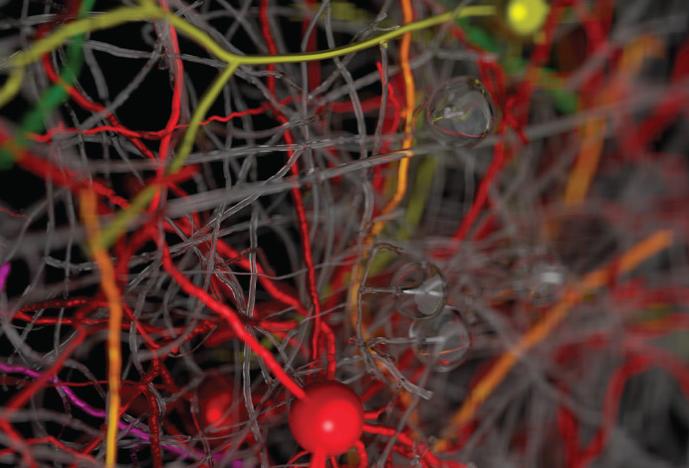
Researchers found that although neurons are embedded amid functionally diverse axons and dendrites, each tends to connect with other neurons with similar properties. These like-to-like (shown in the same color) connections also are larger than like-to-unlike connections.
How does consciousness emerge from the maze of neurons in the human brain? How do we and other animals process chaotic sensory inputs from our environments well enough to initiate appropriate behaviors and solve problems?
Answers to such questions have remained out of reach in part because the neural networks in our brains are so complex. Multiply 86 billion neurons by 1,000 connections each and things quickly get out of hand.
Researchers have been making headway, largely by following two separate paths: differentiating neurons by function or mapping connections among neurons to uncover circuits.
Some neurobiologists are trying to guide those paths toward convergence by investigating how structure and function are related. Wei-Chung Lee, an HMS instructor in neurobiology, is one such scientist. He and his colleagues are pursuing so-called cellular functional connectomics. By developing faster microscopes and more powerful computing tools and asking the right questions, they are linking anatomical infrastructure to neural circuit activity in the visual cortices of mice.
In 2011, Lee, graduate student Davi Bock, and R. Clay Reid, a former HMS professor of neurobiology who is now at the Allen Institute for Brain Science in Seattle, used two-photon microscopy to show how the functional properties of inhibitory neurons that form neural circuits could be predicted based on how they are wired with surrounding neurons in their local circuit.
But “we were just tickling the brain in terms of physiology,” Lee says.
To advance the work, Lee, Reid, and Vincent Bonin, now at Neuro-Electronics Research Flanders in Belgium, shifted their gaze from inhibitory neurons to excitatory neurons, which account for about 70 percent of cells in the cerebral cortex. This spring, they directly demonstrated for the first time that excitatory cortical neurons are organized into modular subnetworks defined by their anatomical connectivity.
The researchers first used two-photon microscopy to see which neurons in the visual cortex fired as the mice watched various stimuli across twelve days. Then the investigators used an electron microscope they’d modified for high-throughput imaging to track connections among the cells and construct a wiring diagram.
They found that neurons with similar functions, such as recognizing vertical lines, formed more connections with one another than with other neurons, even if those other neurons were close by. Synapses, the junctions where information jumps from one neuron to another, were also larger between functionally related neurons.
According to the researchers, subnetwork connection patterns may amplify relevant sensory signals enough to get through the cortex’s inhibitory filter.
The researchers think the information-processing principles being revealed in mice will apply across other animal species. They hope future work in the field will illuminate how neuronal networks are constructed during development, how they change in response to plasticity, and how they go awry in disease, including proposed “connectopathies” such as schizophrenia and autism.
Image: Alex Norton, Sam Ingersoll, Clay Reid, and Wei-Chung Allen Lee